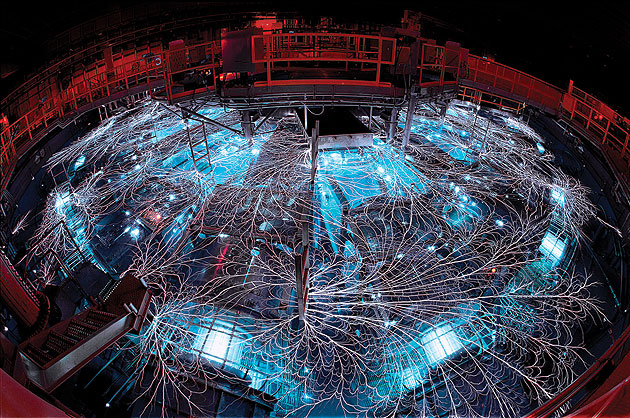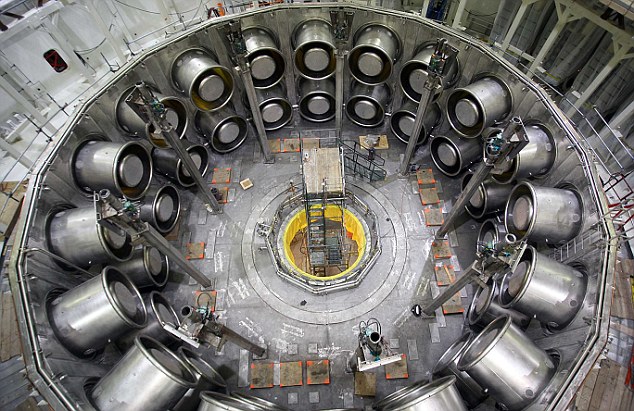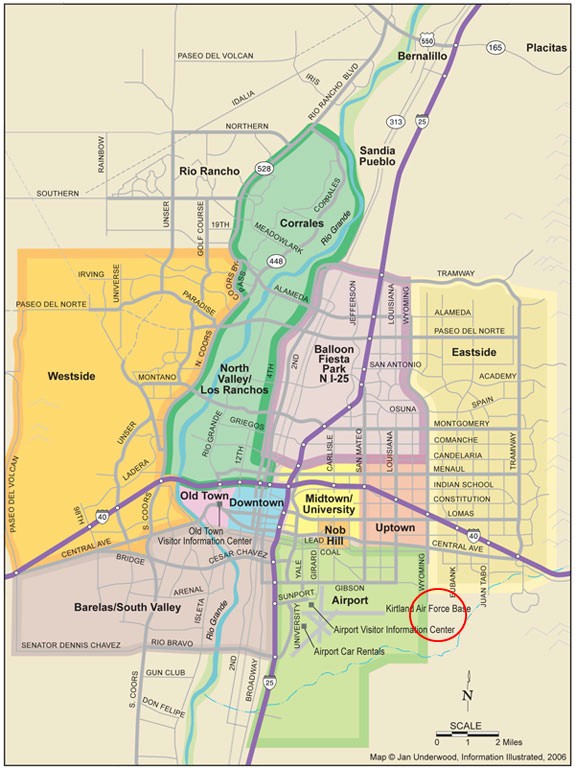
TARGET 090527
Power!!! More Power!!!

The central vacuum chamber of the Z Machine, above, is 10ft in diameter and 20ft deep, surrounded by banks of capacitors - the enormous 'batteries' used to store the charge that fire the machine. When the wires that are inside the tiny 'target' are vaporised, the tungsten threads are forced to travel inwards at a speed of over 3,000 miles per second, and the result is that enormous sudden release of energy. The powerful fluctuation in the magnetic field when the machine is discharged generates an electric current in all the metallic objects in the chamber - hence the impressive lightning or 'arcs and sparks' seen here. The 36 cables feeding the energy pulse into the Z Machine are insulated by chambers containing two million litres of insulating oil and two million litres of deionised water. While the Z Machine can generate an extraordinary pulse of energy, it only does so for a tiny fraction of a second - the power used is only enough to provide electricity for 100 houses for two minutes, and is supplied by the local electricity company via a wall socket.
Based at Sandia National Laboratories, on Kirtland Air Force base in Albuquerque, New Mexico, it is used to research thermonuclear reactions - for example, what happens at the heart of a hydrogen bomb detonation. Now it has a more productive application: finding a way to fuse heavy water atoms to create fusion power. Fusion is the Holy Grail of the power industry: cheap, clean, safe and unlimited. The downside is, with current technology, the reaction is difficult to control.
When the machine fires, 36 cables - each as thick as a horse's torso - spark simultaneously. The cables fire a pulse of 50 trillion watts into a target the size of a cotton reel. Inside the target is a can filled with wires finer than a human hair. The wires vaporise, creating temperatures as high as 3.5 billion degrees C, the highest ever created by man and an X-ray pulse in excess of 290 terawatts.

Originally designed to supply 50 terawatts of power (enough to power 50 million homes) for a burst less than 100 nanoseconds, the Z Machine was redesigned to supply 290 terawatts of power. The electric discharge created at the instant of the A-pinch is so massive that sparks jump off every metallic object in the room where the Z Machine is located. The effect produced photos that represent some of the most memorable science photography of 2005. The electric discharge still occurs despite the power feeding equipment being submerged in 2,000 cubic meters of transformer oil and an additional 2,300 cubic meters of deionized water. The discharge is known as "arcs and sparks" or just "lightning."
FEEDBACK MAP

Mail Online
Wikipedia
Popular Mechanics